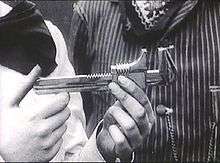The Lonedale Operator
The Lonedale Operator[1] is a 1911 short American drama film directed by D. W. Griffith, starring Blanche Sweet and written by Mack Sennett for the Biograph Company. The plot of the film involves a girl who takes over a telegraph station after her father takes ill. After the payroll for the town's mine is delivered, two drifters try to steal the money. Their robbery is foiled because the girl is able to telegraph for help and then hold the would-be robbers off until help arrives. The Lonedale Operator includes "elements of romance, drama, suspense, Western, and even a bit of comedy near the end."[2]
| The Lonedale Operator | |
|---|---|
 A close-up of a wrench, from the climax of The Lonedale Operator | |
| Directed by | D. W. Griffith |
| Produced by | D. W. Griffith |
| Written by | Mack Sennett |
| Starring | Blanche Sweet Verner Clarges |
| Cinematography | G. W. Bitzer |
| Distributed by | Biograph Company |
Release date |
|
Running time | 17 minutes (16 frame/s) |
| Country | United States |
| Language | Silent |
Unlike most films at the time which had a simple plot line set in one location, The Lonedale Operator "intercuts three primary spaces—the telegraph office interior, the criminals outside, and the rescue train."[3] Although audiences in 1911 were not used to such editing, the use of the telegraph helped them understand the crosscutting between scenes in such a way that they could follow the plot.[4] The film is also significant for Griffith's use of a close-up of a wrench, which the girl had pretended was a gun. At the time of the film's release, close-ups were still uncommon. The Lonedale Operator illustrates Griffith's growing mastery of the medium.[5]
A print of the film survives in the film archive of the Museum of Modern Art in New York City.[6]
Cast
- Verner Clarges as In Payroll Office
- Guy Hedlund as On Train
- Jeanie Macpherson as In Payroll Office
- W. C. Robinson as In Payroll Office
- Edward Dillon as Telegrapher (uncredited)
- Francis J. Grandon as The Engineer (uncredited)
- Joseph Graybill as A Tramp (uncredited)
- Dell Henderson as A Tramp (uncredited)
- Wilfred Lucas as The Fireman (uncredited)
- W. Chrystie Miller as In Station Lobby (uncredited)
- George Nichols as The Lonedale Operator (uncredited)
- Blanche Sweet as Daughter of the Lonedale Operator (uncredited)
- Charles West as Company Agent (uncredited)
References
- Griffith, G.W. (1911). "The Lonedale Operator" (Complete Film).
- "The Lonedale Operator (1911)". Cinema Century. Retrieved February 3, 2013.
- "The Lonedale Operator (1911)". Preserved Films. National Film Preservation Foundation. Retrieved February 3, 2013.
- Young, Paul (2005). "Media on Display: A Telegraphic History of Early American Cinema". In Gitelman, Lisa (ed.). New Media: 1740-1915. MIT Press. pp. 230–264. ISBN 9780262572286.
- Ellenberger, Allan R. "The Centenary of the close-up". Hollywoodland: A Site About Hollywood and Its History. Retrieved February 3, 2013.
- "Silent Era: The Lonedale Operator". silentera. Retrieved February 3, 2013.